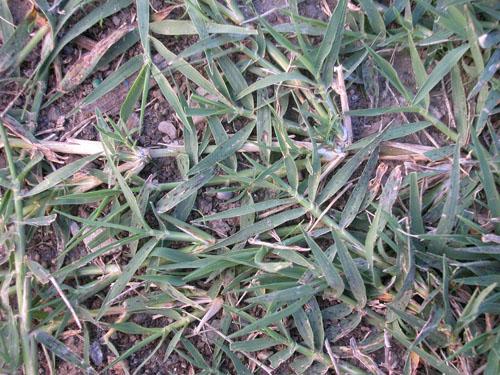Love ‘em or hate ‘em they are hard to ignore – whether they are producing lovely flowers or taking over the garden!
What really is a weed?
Basically, it is a plant growing where you don’t want it to grow. When caring for your low-water use, climate-appropriate garden, weeds can overtake a garden (especially after a good season of rain) competing with your plants for water, nutrients, light and dominating the space.
At first, they seem harmless. However, left to grow, they continue to spread their seeds each year and can take over your sustainable landscape.
Some common weeds and how they spread
Dandelion (Taraxacum officinale)

This classic weed with its bright yellow flowers in the spring transforms into round puffs. Who doesn’t remember pulling off a long stem and making a wish before blowing the fluff into the air? This fluff is actually parachutes of seeds that are blown into the surrounding area.
Bermuda Grass (Cynodon dactylon)

This low growing grass has above- and below-ground shoots (rhizomes) that make getting rid of this grass very difficult. The rhizomes take root as they travel under the ground, along walls, under sidewalks and more. They can grow as much as 6’ deep, but most of the roots and rhizomes are found in the top 6” of soil.
Oxalis (Oxalis pes-caprae)

This plant with its bright green, clover-shaped leaves and yellow flowers, looks pretty when blooming, but can take over an entire yard over time. Small underground bulbs multiply, so don’t remove soil from an infested site to another area as this will cause them to spread.
Mustard (Brassica spp.)

An annual plant with small, pale yellow flowers. Wild mustard produces 2,000 and 3,500 seeds throughout its life. They drop to the ground and germinate creating thick patches of the weed. When they turn brown in summer, they become fuel for fire.
Burclover (Medicago polymorpha)
This low-growing groundcover with small, yellow flowers produces clusters of round, spiny burs filled with seeds. Once these seeds dry out, they can stick to animal fur or skin – and really hurt!
Redstem filaree, Redstem stork’s bill (Erodium cicutarium)
This low-growing plant has small, purple flowers. Its seeds are lance-shaped with fine hairs that when release from the plant, coil up in tight spirals that act to drill in the soil or attach to animal fur.
Foxtail (Hordeum murinum)
This invasive grass produces seed heads that resemble wheat or barley. Once they dry out in the summer, the barbed seeds spread and also stick to animal fur.
How can I reduce weeds without using herbicides?
Keep at it! The best thing to do to maintain your garden and prevent weeds from taking over is to continually remove them. Here are some other hints for success:
- Remove the entire plant – including the roots. A lot of weeds have deep tap roots. When removing the plant, be sure to get the entire root to help ensure they don’t grow back. However, continue to pull weeds, even if you don’t get the entire plant. Without leaves needed for photosynthesis, the plant will eventually die.
- Trim or remove the plant before it goes to seed. Some varieties of weeds produce thousands of seeds. To help ensure they don’t continue to spread, remove the weeds before they get a chance to flower and produce seeds.
- Mulch! A good 3 – 4 inch layer of mulch over bare soil in the garden will help to suppress weeds throughout their growing season. Mulch serves to block sunlight so they don’t germinate. For some of the persistent grasses, try sheet mulching. Go here for a great video.
- Clean your tools after working in the yard. Tools should be cleaned to prevent diseases and weed seeds from spreading through the landscape. Go here for our blog on how to clean your tools.
- If they have gone to seed, don’t put pulled weeds into your compost bin. Unless you are sure the bin will get hot enough to kill the seeds, you may end up spreading dormant seed when using your compost. Instead, put the seed-heads in your City’s green bin. The rest of the plant can go in your compost bin (except Bermuda grass).
- Don’t plant weeds! Some weeds are beautiful, which is how they entered the nursery trade (Mexican feather grass, English ivy, etc.). Research plants to see if they are invasive species before purchasing them. Use this guide to learn what plants to avoid. Another resource is the California Invasive Plant Council’s (Cal-IPC) database of invasive plants.
Want to learn more? Join us for a hands-on workshop on maintaining your sustainable landscape
Join us on Saturday, June 9 for a 4-hour Sustainable Landscape Maintenance Workshop that will cover soil health, plants and pruning, irrigation and watering considerations, rain barrels and more. Go here to register. This workshop is sponsored by Los Angeles Department of Water and Power for customers in the LADWP service area.

